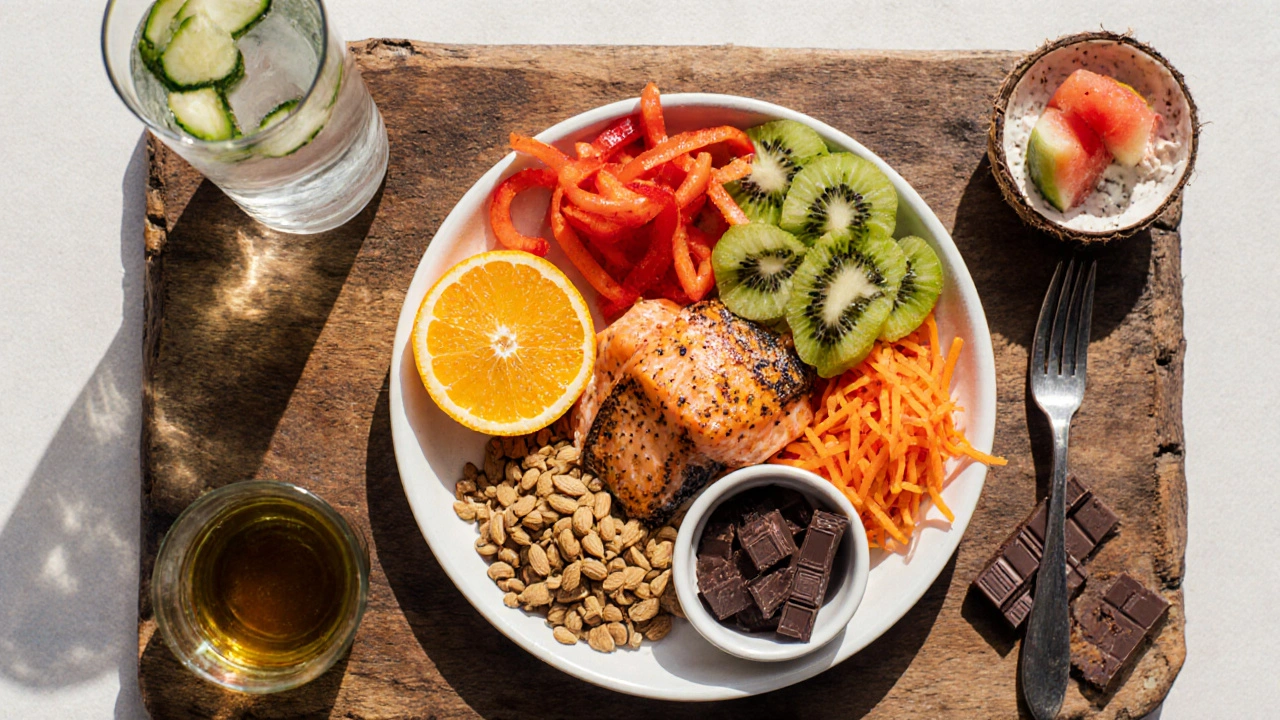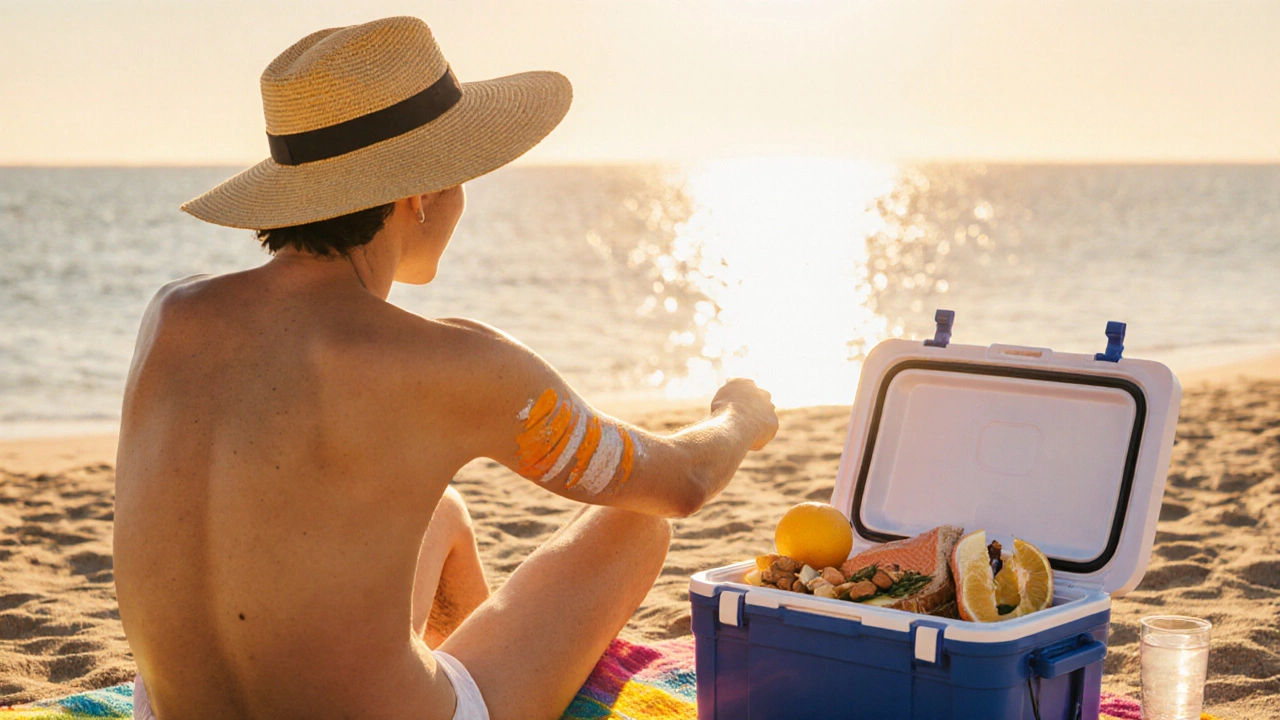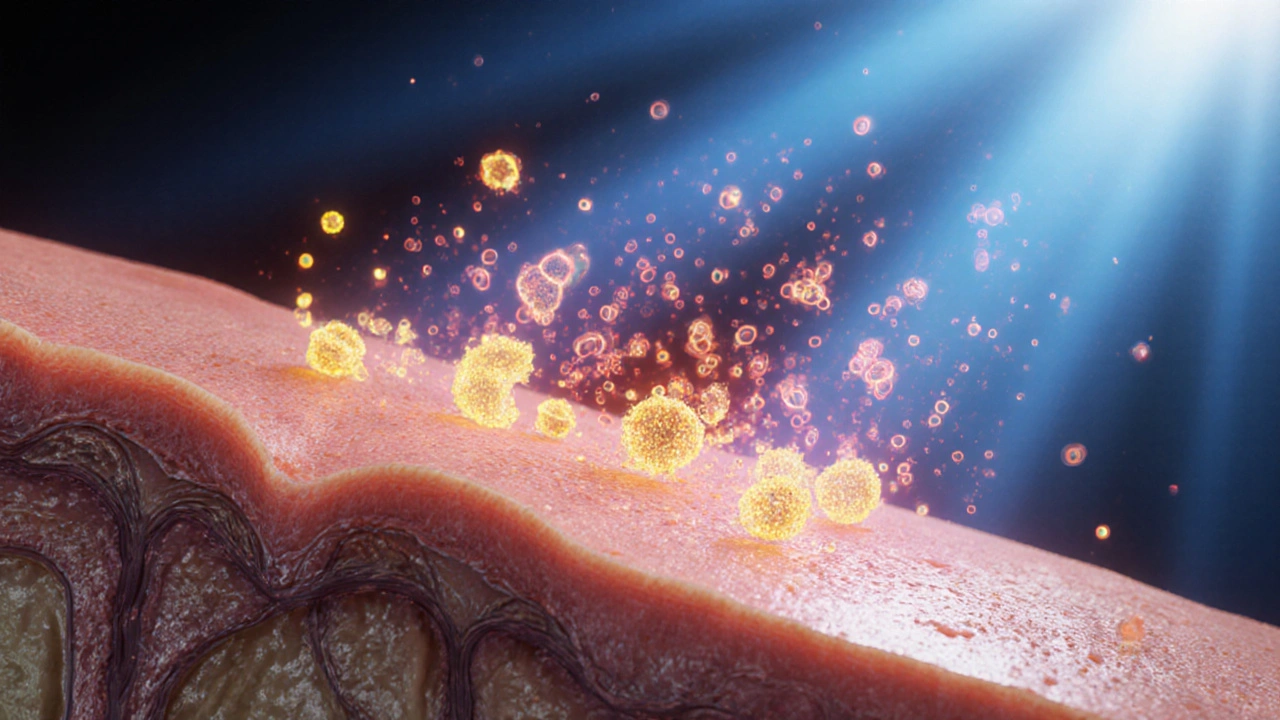Sunburn Protection Nutrition Calculator
Select Your Daily Food Choices
Vitamin C
Citrus fruits, kiwifruit, red bell peppers, broccoli
Vitamin E
Almonds, sunflower seeds, avocado, wheat germ
Beta-Carotene
Carrots, sweet potatoes, pumpkin, apricots
Omega-3
Fatty fish, chia seeds, walnuts
Polyphenols
Green tea, berries, dark chocolate, red grapes
Electrolytes
Coconut water, cucumber, watermelon, ORS drinks
Your calculated sun protection score and recommendations will appear here.
Key Takeaways
- Sunburn damage starts with UV‑induced free radicals; antioxidants in food can neutralize them.
- Vitamin C, vitamin E, beta‑carotene, omega‑3s and polyphenols are the top skin‑protective nutrients.
- Eating a colorful plate 2-3 weeks before sun exposure builds a natural sunscreen from the inside.
- Staying hydrated and balancing electrolytes supports skin barrier repair after a burn.
- A simple daily meal plan can boost skin resilience without relying on expensive supplements.
When the sun’s UV rays hit your skin, they trigger a cascade of chemical reactions that can leave you red, painful, and prone to long‑term damage. While sunscreen is a must, what you put on your plate can be just as powerful. This guide explains how specific foods and nutrients act like an internal shield, helps you choose the right meals before a beach day, and offers a practical eating plan to keep your skin healthy year‑round.
What Actually Causes Sunburn?
Sunburn is an acute inflammatory response to ultraviolet (UV) radiation, especially UV‑B (280‑320nm). When UV photons penetrate the epidermis, they break molecular bonds in skin cells, creating reactive oxygen species (ROS) - unstable molecules that damage DNA, proteins, and lipids. Your body’s natural antioxidant systems - enzymes like superoxide dismutase and glutathione peroxidase - scramble to neutralize ROS. When the overload exceeds these defenses, inflammation spreads, blood vessels dilate, and you see the classic red, hot patch of skin.
Understanding this biochemical battle is the first step to using nutrition as an ally. Foods rich in antioxidants replenish the very molecules your skin burns through, while certain fats help rebuild damaged cell membranes.
How Nutrition Interacts With Skin Defense
Every nutrient mentioned below has a clear, evidence‑backed role in skin protection. Below is a quick snapshot of the main mechanisms:
- Vitamin C (a water‑soluble antioxidant that supports collagen synthesis and neutralizes free radicals) - boosts the skin’s structural matrix and quenches ROS.
- Vitamin E (a fat‑soluble antioxidant that protects cell membranes from lipid peroxidation) - works synergistically with vitamin C to repair UV‑induced damage.
- Beta‑carotene (a provitamin A carotenoid that absorbs UV light and reduces erythema) - stored in the skin, it provides a subtle, natural tan.
- Omega‑3 fatty acids (essential polyunsaturated fats that modulate inflammation and support cell membrane fluidity) - lower the inflammatory response after UV exposure.
- Polyphenols (plant compounds with strong antioxidant activity, found in tea, berries, and cocoa) - directly scavenge ROS and may up‑regulate skin protective genes.

Top Nutrients for Sunburn Prevention - A Comparison Table
| Nutrient | Primary Skin Benefit | Best Food Sources |
|---|---|---|
| Vitamin C | Boosts collagen, neutralizes ROS | Citrus fruits, kiwifruit, red bell peppers, broccoli |
| Vitamin E | Protects cell membranes, works with vitamin C | Almonds, sunflower seeds, avocado, wheat germ |
| Beta‑carotene | Absorbs UV, reduces redness | Carrots, sweet potatoes, pumpkin, apricots |
| Omega‑3 (EPA/DHA) | Reduces inflammation, improves membrane repair | Fatty fish (salmon, mackerel), chia seeds, walnuts |
| Polyphenols | Scavenges free radicals, up‑regulates protective genes | Green tea, blueberries, dark chocolate (≥70% cocoa), red grapes |
| Water & Electrolytes | Maintains skin hydration, aids toxin removal | Water, coconut water, cucumber, watermelon, ORS drinks |
Everyday Foods That Build a Natural Sunscreen
Instead of thinking about “sun‑proof” meals, consider a colorful plate that hits all the nutrient boxes above. Here’s a sample day that delivers more than 200% of the recommended daily values for the key antioxidants:
- Breakfast: Greek yogurt topped with fresh blueberries, sliced kiwi, and a drizzle of honey. Add a handful of toasted almonds for vitaminE.
- Mid‑morning snack: A small glass of orange juice and a carrot stick.
- Lunch: Spinach and quinoa salad with grilled salmon, cherry tomatoes, avocado, and a lemon‑olive‑oil dressing. Sprinkle pumpkin seeds for extra beta‑carotene.
- Afternoon boost: Green tea (steeped for three minutes) and a few squares of 70% dark chocolate.
- Dinner: Stir‑fried bell peppers, broccoli, and snap peas in sesame oil, served over brown rice. Finish with a squeeze of fresh lime.
- Hydration: Sip water throughout the day; add slices of cucumber and watermelon for electrolytes.
Eating this way for at least two weeks before a planned outdoor activity can noticeably raise your skin’s tolerance to UV. Studies have shown a 20‑30% reduction in sunburn severity among participants who followed a high‑carotenoid diet for 4weeks.
Hydration and Electrolyte Balance - The Unsung Heroes
Dehydrated skin loses its barrier function faster, making UV damage more pronounced. Aim for 2.5-3L of water daily in hot weather, and top up with electrolyte‑rich drinks (coconut water, low‑sugar sports drinks) if you’re sweating heavily. Sodium, potassium, and magnesium help maintain cell integrity, allowing skin cells to repair more efficiently after a burn.

Sample 7‑Day Meal Plan for Sun‑Ready Skin
- Day1: Oatmeal with sliced strawberries, chia seeds, and a splash of orange juice.
- Day2: Smoothie (spinach, mango, Greek yogurt, flaxseed) + handful of walnuts.
- Day3: Whole‑grain toast with avocado, poached egg, and a side of roasted sweet potatoes.
- Day4: Tuna salad with mixed greens, olives, bell peppers, and a vinaigrette.
- Day5: Lentil soup, side of quinoa, and a kiwi‑orange fruit salad.
- Day6: Grilled chicken breast, steamed broccoli, brown rice, and a cup of green tea.
- Day7: Baked salmon, asparagus, mashed cauliflower, and a small piece of dark chocolate for dessert.
Rotate these meals, add seasonal fruits and vegetables, and you’ll keep a steady supply of the protective compounds your skin needs.
Common Mistakes to Avoid
- Relying on a single “superfood.” No one food covers all bases; diversity is key.
- Skipping meals before sun exposure. Fasting depletes glycogen stores, reducing the energy needed for cellular repair.
- Over‑supplementing. Mega‑doses of beta‑carotene can cause a harmless orange tint but may interfere with vitaminA metabolism.
- Neglecting hydration. Even the best antioxidants can’t work properly without water to transport them.
Putting It All Together - Your Action Checklist
- Plan a colorful menu at least 14days before a beach trip.
- Include a source of vitaminC, vitaminE, beta‑carotene, omega‑3, and polyphenols every day.
- Drink 2.5-3L of water plus electrolyte‑rich fluids when it’s hot.
- Apply broad‑spectrum sunscreen (SPF30+) as the first line of defense.
- After sun exposure, replenish with hydration, antioxidant‑rich snacks, and gentle moisturizers.
Frequently Asked Questions
Can I get enough sun protection from food alone?
Food can boost your skin’s internal defenses, but it isn’t a replacement for topical sunscreen. Think of diet as a supportive layer that reduces the severity of burns and aids recovery.
How long before sun exposure should I start the protective diet?
Research indicates 10‑14days of consistent intake of antioxidant‑rich foods yields measurable improvements in skin resilience.
Is beta‑carotene safe for everyone?
Generally yes, but smokers should avoid high supplemental doses because beta‑carotene may increase lung cancer risk in that group. Food sources are safe for most people.
Do I need to take vitamins if I eat a balanced diet?
If your meals consistently include the foods listed in the table, additional supplements are usually unnecessary. Talk to a healthcare professional if you have specific deficiencies.
What’s the best way to stay hydrated on a hot day?
Sip water regularly, not just when you feel thirsty. Adding a pinch of sea salt or a splash of citrus can improve taste and replace electrolytes lost through sweat.


Aminat OT
October 5, 2025 AT 13:20I swear I get sunburned even after a single beach day.
Amanda Turnbo
October 6, 2025 AT 08:47While the guide offers a commendable overview of micronutrient benefits, one must question whether the suggested daily portions are practically attainable for the average individual juggling work and family commitments. The recommendation to consume large doses of beta‑carotene, for instance, may be unrealistic without a conscious dietary overhaul.
Jenn Zuccolo
October 7, 2025 AT 04:14Consider, if you will, the philosophical underpinnings of internal versus external protection: the skin’s barrier is not merely a passive shield but a dynamic organ shaped by the very foods we ingest. By integrating antioxidants, we are, in effect, cultivating a philosophy of self‑sufficiency against environmental stressors.
Courtney The Explorer
October 7, 2025 AT 23:40From a systems‑level perspective, the synergy of Vitamin C + E = enhanced photoprotection; beta‑carotene acts as a photonic filter; omega‑3s modulate cytokine cascades. The integration of these pathways is not optional – it’s a strategic national health imperative.
Ashleigh Connell
October 8, 2025 AT 19:07Honestly, the article makes a lot of sense – adding colorful fruits and staying hydrated is something anyone can do. I’ve started swapping soda for water with a slice of cucumber, and my skin feels less tight after a day in the sun.
Erin Knight
October 9, 2025 AT 14:34In truth, the calorie‑centric approach glosses over the fact that antioxidant bioavailability varies dramatically with food matrix. A spoonful of almond butter does not equate to the same plasma vitamin E levels as raw almonds, yet the guide treats them identically.
Kavita Jadhav
October 10, 2025 AT 10:00That’s a solid point. I’d add that timing matters: consuming vitamin C‑rich foods with a bit of iron‑rich spinach can boost absorption, making the protective effect even stronger.
Tony Halstead
October 11, 2025 AT 05:27Great observations everyone. Let’s remember that skin health is a holistic endeavor – stress management, sleep, and regular physical activity all complement the antioxidant diet. Consistency over weeks is key; sporadic bursts won’t rewire the skin’s defenses.
leo dwi putra
October 12, 2025 AT 00:54Whoa, totally feel you on the consistency vibe! I once tried a “one‑week only” salad binge and my skin was still as flaky as ever. It’s like trying to charge a dead phone with a tiny charger – you need steady power.
Krista Evans
October 12, 2025 AT 20:20Hey team, just wanted to shout out that adding a splash of lemon to your water not only boosts vitamin C intake but also makes hydration feel more exciting. Small tweaks keep us motivated to stick with the plan!
Mike Gilmer2
October 13, 2025 AT 15:47Honestly, the drama of “sun‑savvy meals” is overblown. I can throw a handful of nuts in my bag and call it a day – the rest is just marketing fluff.
Alexia Rozendo
October 14, 2025 AT 11:14Sure, if you enjoy living on the edge of nutrition nihilism, go ahead. Meanwhile, the rest of us are actually seeing benefits when we follow the antioxidant plan.
Kimberly Newell
October 15, 2025 AT 06:40i think its cool how easy it is to just add a banana or some almonds to a snack and get those nutrients without any big changes.
Drew Burgy
October 16, 2025 AT 02:07Look, the mainstream health advice is a distraction. The real story is that big sunscreen corporations fund these “nutrient” recommendations to keep us buying their products.
Jacob Hamblin
October 16, 2025 AT 21:34I appreciate the balanced perspective. It’s worth noting that the recommended water intake can differ based on individual metabolic rate and climate, so adjusting the volume accordingly is sensible.
Andrea Mathias
October 17, 2025 AT 17:00Honestly, the United States should prioritize home‑grown superfoods rather than importing exotic produce. Our own farms can supply the needed beta‑carotene if we support local agriculture.
TRICIA TUCKER
October 18, 2025 AT 12:27Love the community vibe here! Just a quick tip: sautéing carrots with a dash of olive oil actually enhances beta‑carotene absorption, so it’s a win‑win for taste and skin protection.
Dave Tu
October 19, 2025 AT 07:54While the suggestion to sauté carrots is valid, it fails to consider that excessive heat can degrade certain phytonutrients. A balanced approach would be to combine raw and lightly cooked forms.
Johnna Sutton
October 20, 2025 AT 03:20In light of the above, it is imperative that policy makers enforce stricter labeling standards for processed foods, ensuring consumers are fully aware of nutrient losses during manufacturing processes.